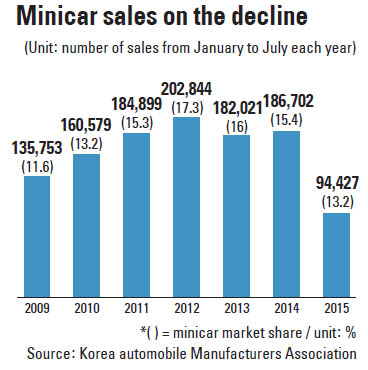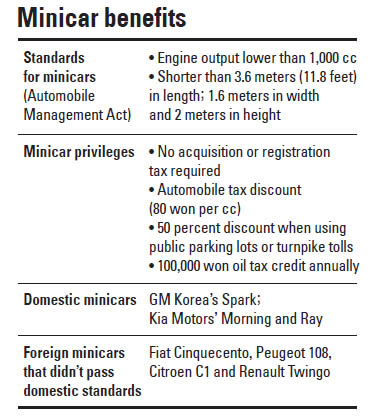Spark hopes to ignite minicar market

The upgraded Spark sold 6,987 units last month, taking first place in the Korean minicar market, followed by Kia Motors’ Morning (6,954 units) and Ray (1,958 units).
It has been nearly eight years since the sales of GM Korea’s Spark have beaten those of Kia Motors’ Morning.
However, the domestic minicar market has stagnated in recent years. The Spark is GM Korea’s first new minicar in six years, while Kia Motors has not launched a new version of its Morning or Ray models since 2011.
“Automobile manufacturers focus on developing their flagship mid-size and full-size sedans or their popular SUVs while neglecting their minicars,” said Lee Nam-seok, an economy professor at Chung-Ang University.
One reason that local automakers are less focused on the category is because the domestic market for minicars is shrinking. In 2012, minicars represented 17.3 percent of the overall domestic auto market with 200,000 units sold. Last year, only 186,702 units were sold, and by the first half of this year, the category’s market share was just 13.2 percent.
Korea’s decreasing demand for minicars is considered odd compared to other countries, where they’re among the most popular models overall. In Japan, minicars account for 40 to 50 percent of total auto sales. Out of the 10 best-selling cars in Japan, seven are minicars, including the top-ranked Daihatsu Tanto.
In Korea, minicars are considered the most economically sensible option for consumers. A new minicar costs around 10 million won ($8,500) and buyers are automatically exempted from acquisition or registration taxes. They also receive a 50 percent discount when using public parking lots and turnpike tolls, and an additional price cut on their car insurance.
“Minicars are the most cost-effective automobiles,” said Yoon Ji-na, 33, who has driven a Spark for the last three years. “Unless someone wants to show off an expensive car regardless of its exorbitant running cost, I think a minicar is their best option.”
Despite the benefits minicars provide, buyers are shying away from the models because there aren’t many to choose from. This is in part because of the Automobile Management Act’s strict standards for what constitutes a minicar. According to the regulation, a minicar must be less than 3.6 meters (11.8 feet) in length, narrower than 1.6 meters in width and shorter than 2 meters in height. The only cars that fit the standard are Kia Motors’ Morning and Ray and GM Korea’s Spark.

Imported options like the Fiat Cinquecento, Peugeot 108, Citroen C1 and Renault Twingo aren’t considered minicars according to the regulations, and since they don’t receive the discounts as a result, they’re ignored by Koreans despite their popularity in European countries.
The stagnating economy has also impacted minicar sales. Younger consumers are usually the ones who purchase inexpensive models like minicars, but these days people are waiting longer to buy their first car. As consumers get older, they tend to purchase more expensive models, which pushes minicars sales down further. Consumers in their 20s bought 109,671 cars last year, a decline of 1.7 percent from 2013. Over the same period, the ratio of new buyers fell from 9 percent to 8 percent.
“Minicars are certainly tempting as a first car, but now I’m over 30 and married, so I need a car that I can use for at least the next decade,” said Kim Sae-young, 33, owner of a Hyundai Motors compact SUV Tucsan. “Since it’s a diesel car, gas prices aren’t bad.”
The future doesn’t seem bright for minicars, as the government recently tried to take away the acquisition tax exemption given to minicar buyers. The decision was made to maintain the benefit until 2018, but it’s unclear how much longer it will last after that.

“The government needs to reform the definition of a minicar,” said Professor Lee. “Also, if minicar prices rise, consumers will reconsider buying one.”
Yoon Dae-sung, an executive director at the Korea Automobile Importers & Distributors Association, agreed with his assessment.
“The two local automakers that monopolize the domestic minicar market are trying to keep out foreign automakers,” said Yoon.
“The government needs to amend the definition of the minicar to give customers a wider selection of choices.”
BY KIM KI-HWAN [choi.jeongpil@joongang.co.kr]










with the Korea JoongAng Daily
To write comments, please log in to one of the accounts.
Standards Board Policy (0/250자)